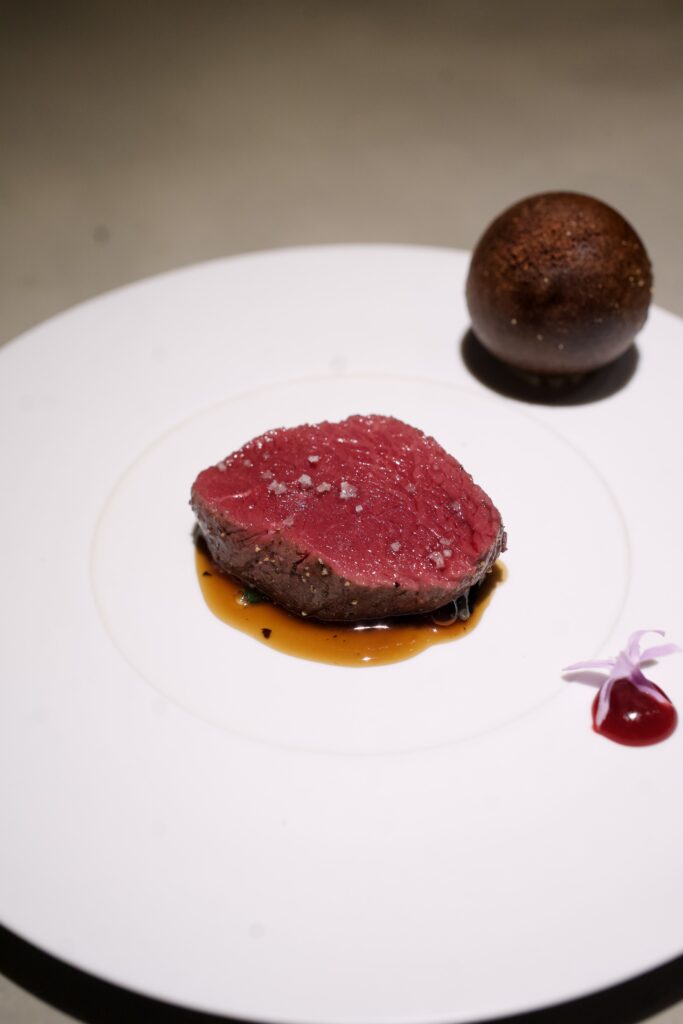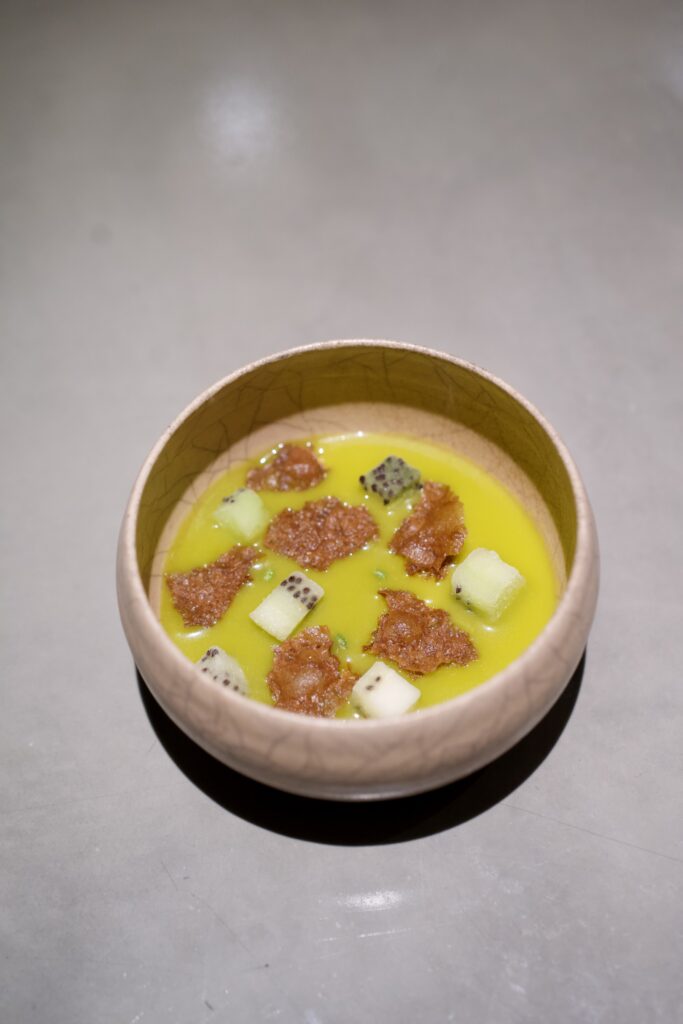On my recent trip to Japan, we visited Kanazawa for the very first time. Located on Japan’s West Coast, about two hours from Tokyo by train, the city is renowned for its rich history and stunning scenery. Interestingly, for once, our choice of destination wasn’t motivated by food. In fact, it wasn’t until a week before our visit to Respiración that I even heard of the restaurant. A trusted friend recommended it, and I took his advice without hesitation.
At first, securing a table seemed impossible—the restaurant was fully booked, but fortune smiled on us as they had space in the kitchen. The heart and soul of any restaurant and a perfect spot for dinner.
Impact Shrimp


Our journey began with a snack as exquisite as the painted glass plate it was served on: a shrimp tart enveloped in condensed rice milk aged for two years. Shrimp tarts are common in Europe, but this was a revelation. The rice milk, pure and sweet, harmonized beautifully with the delicate shrimp, creating a bite that was both unexpected and unforgettable.
Mar

From the ocean’s depths, we moved to Kanazawa’s cold coastal waters with a lightly cooked clam accompanied by a delicate leche de tigre infused with kaffir lime. The citrus brought a floral brightness that elevated the dish. This combination of local ingredients and global techniques would be a common thread through out our wonderful dinner
Setas



The next dish showcased a majestic maitake mushroom, prepared in three ways. First, a small crispy ball, then paired with mousse and fresh fig, and finally, grilled and smoked alongside a turkey dumpling. To amplify the umami, they poured a miso broth made from leftover bread. This course was a symphony of rich, layered flavors—a stunning example of their ability to marry exceptional ingredients with traditional Japanese techniques for extraordinary results.
Calamar

If you’ve followed my culinary adventures, you’ll know I’m a fan of sweet accents in savory dishes. This next creation hit all the right notes. Aged for three days, the calamari was brushed with a pumpkin sauce enriched by citrus and ebi shrimp. Citrus was a recurring motif throughout the meal, adding floral brightness and balancing richness with finesse. It made me wonder: why don’t we embrace citrus more in Denmark?
Oso

One of the joys of travel is encountering ingredients and traditions that challenge our expectations and traditions. The next dish was one of those moments: mountain bear, a local delicacy in Japan. Served as a hearty ragù with sweet potato, béchamel, and a ship’s leaf, the dish was comforting, rich, and utterly satisfying.
Pescado

Next was perhaps the simplest dish of the night: a perfectly cooked piece of grouper served with a cauliflower sauce, black yuzu, and finger lime. The citrus elements were, once again, flawlessly executed, cutting through the creamy sauce and enhancing the crisp, golden fish skin. While the preparation hinted at the chefs’ time in Spain, it was their Japanese touch that elevated this dish.
A Refreshing Pause

Before the main courses, we were treated to a plum pressed with rose vinegar—a small but powerful palate cleanser that proved how little it takes to create greatness when skill and exceptional ingredients come together.
Carne

We ventured back to the forest with lightly cooked venison, its delicate flavor preserved by gentle preparation. Watching the open fire in the kitchen, I couldn’t help but wish for just a hint of smoke to round out the dish.
Paella

Though Respiración is categorized as a Spanish restaurant on Google, its Spanish influences had been subtle—until now. The paella was a bold homage to the iconic dish, cooked with fish stock and crowned with sweet, succulent crab. Authenticity aside, it was simply delicious.
Cedra

Dessert began with a harmonious blend of lovage and cedar crème, paired with semi-frozen kiwi and a crunchy cracker. The semi-frozen kiwi was a clever touch, adding both texture and temperature contrast to this elegant dish.
Pera

The final dessert was a showstopper: pear and sake, a pairing that married flavor and technique with precision. The dish reminded me that Spanish influences at Respiración extend beyond flavor—they also embrace innovation and craftsmanship.



Petit fours and tea ended the meal with the same level of dedication as every preceding course. The tea was an infusion made from nine fresh herbs, and the petit fours were technical masterpieces.
The Soul of Respiración
The word Respiración means breathing or catching your breath, and the restaurant truly lives up to its name. It took my breath away while also providing a tranquil space for reflection and focus.
Going into this dinner, I didn’t know what to expect. The restaurant’s Instagram looked promising, and its two Michelin stars gave it prestige, but I hadn’t heard any buzz. By the first bite, my doubts dissolved. The flavors were striking—a perfect balance of exceptional ingredients and refined technique.



Housed in a 150-year-old building, the restaurant’s interior is understated yet elegant, with soft lighting and beautiful ceramics that evoke a sense of peace.
When you put all of this together you get a unique identity and rich personality which to me is very rare as most restaurants don’t have this many dimensions to them. Especially not this coherent
It’s safe to say that the next time I’m in Japan, Respiración will be at the top of my list. And this time, I’ll make sure to spend more time in Kanazawa to truly catch my breath.
Practical information
Location: Kanazawa, Japan
Menu: 11 course tasting menu – 41.000Yen ($270)
Website: respiracion | レスピラシオン 金澤スパニッシュ




No Comments